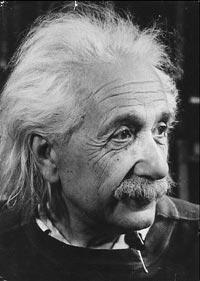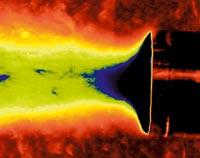Albert Einstein, Annus Mirabilis 2005

Who does not know Albert Einstein? It is known all over the world as an icon of the medium genius. But behind that image was a man: unbridled and somewhat neglected in everyday life, but great as a scientist, if it was great.
He was born in Ulm, Germany, in 1879. And, as is known, he was not a good pupil. It seems that he was skillful in physics and mathematics, but did not pay attention to the rest of the subjects and had discipline problems at school. Somehow he finished his studies, but to get a job he needed the help of an uncle, who went to work at the patent office in Bern, Switzerland.
He preferred reflections on physics rather than office work, and they say that from a young age he imagined that he was going on a ray of light. It was a curiosity to think about how things would look at that speed. That curiosity led him to discover it. According to Albert Einstein himself, he worked more for imagination than for knowledge.
For that man was the one who laid many of the foundations of today's physics. And in that work, 1905 was the most prosperous year: Einstein published five articles. Five important articles. In one of them he published the Special Theory of Relativity. He developed this work between 1907 and 1915 and published the result in 1916 under the name of General Theory of Relativity.
The origin of this work was in the 1905 article. Then, Einstein was only 26 years old and was an unknown in the environment of scientists. However, five original and innovative works were written and published in the journal Annalen der Physik. They worked on the photoelectric effect, Brownian movement, the corpuscular theory of light, the size of molecules and inertial systems. The special theory of relativity was a consequence of the study of inertial systems.
Each of these works would suffice to get into the great physicists Einstein and, taking into account all the works, entered the group of the highest physicists, such as Newton and Archimedes.

However, the Nobel Foundation did not reward all these works, since it received a single prize (in 1921) and it was not for the theory of relativity, but for the work that corresponded to the photoelectric effect.
At first, Einstein did not realize the possible practical applications of his work. But they had it. The atomic bomb itself was designed on the basis of its theories. On the contrary, not all applications have been harmful, for example, space travel and the study of matter are based on Einstein's discoveries.
Einstein at the Kursaal
As can be seen, Einstein himself and his work can arouse anyone's curiosity. And this year will satisfy this curiosity. And it is that, as in other places of the world, in Euskal Herria there will be no shortage of conferences on this great physicist. During the month of September, organized by the International Physics Center of San Sebastian, they will be able to catch up on the field of physics and will approach the people of Einstein Street, with talks open to everyone, prior registration before 31 May. All these days will take place from 5 to 8 September at the Kursaal Congress Palace of San Sebastian. And in the work of speakers there will be very interesting physicists: Biographers Gerald Holton and John Stachel; and six Nobel Laureates: Heinrich Rohrer, Claude Cohen-Tannoudji, Dedley Hershbach, Jean-Marie Lehn, Sheldon Glashow and Antony Hewish. It will be an opportunity to listen to researchers of this level to reflect on Einstein, explaining in a simple way the physics of Einstein that seems so far from the everyday.
In human cell cultures we have shown that antibodies are capable of neutralizing several GIB-1 strains. This type is the most widespread and there are many strains, but as everyone has the same key, the antibody affects everyone. In fact, antibodies bind to the key, thus preventing the fusion of HIV with the cell.
In addition, antibodies act on the other hand, eliminating already infected cells and thus avoiding the proliferation and spread of the virus.

Many other topics will include: Einstein and time; origin and evolution of the universe; black holes; matter and form; relativity, photons and particles... But there will also be conferences like Einstein and XX. one that relates the philosophy of the twentieth century, or another that compares the creativity of Einstein and Picasso.
It is clear that physics will not be the only protagonist of the conference. Also, if you want to know Einstein better, you can not forget the music. And it is that he loved music very much (especially Mozart's works), and not only listening to it, but also acting, which played with humor the violin.





